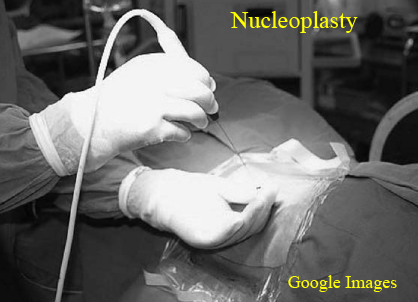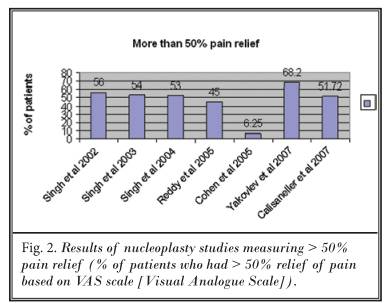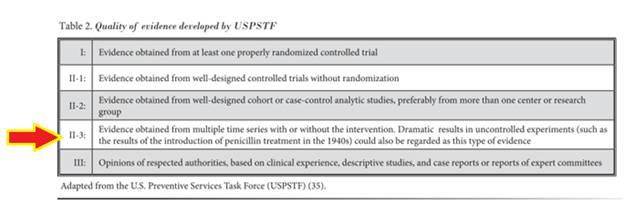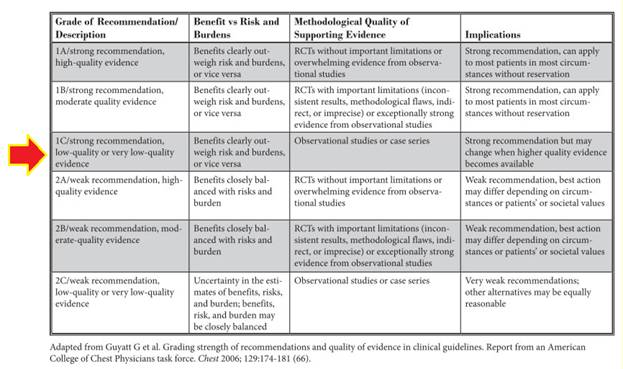Introduction | The Study | Results | Level of Support | Complications | Discussion | Conclusion | Comments
Gerges FJ, Lipsitz SR, Nedeljkovic SS. “A Systematic Review on the Effectiveness of the Nucleoplasty Procedure for Discogenic Pain." Pain Physician 2010;13: 117-132.
Here's a good YouTube animation of Nucleoplasty from the patent holder.
INTRODUCTION:

In July of 2000, the US Food and Drug Administration (FDA) approved Disc Nucleoplasty™ (aka: Nucleoplasty), as a treatment intervention for small contained disc herniations. Unlike the other minimally invasive procedures for disc-volume reduction (i.e., chymopapain chemonucleolysis, automated percutaneous discectomy, percutaneous via the Nucleotome system, percutaneous laser discectomy, and percutaneous discectomy via the DeKompressor system), nucleoplasty uses a unique and patented coblation technology for reducing disc volume—the ultimate goal of all members of this class of procedure.
The delivery system of Nucleoplasty is similar to that of the other procedures: a cannula is inserted adjacent to the posterolateral disc, and then a 1mm diameter, bipolar probe is inserted into the nucleus pulposus (nucleus). Disc-volume change is accomplished by activating the bipolar probe, which in turn generates bipolar radiofrequency energy into the proteoglycan-rich tissue of the nucleus. This applied energy excites the molecules of the nucleus to such an extreme point that they dissociate (breakdown), which causes a loss of nuclear volume and leave small channels within the disc. The reduction in nucleus volume (as will all disc-volume-reduction techniques) drastically reduces the intradiscal pressure, which in turn causes a retraction of the herniation, reduction of the nerve root pressure (the compressive herniation is gone), and a reduction of nerve-receptor pressure on the pain-sensitive sinuvertebral nerves of the outer annulus [49]. In other words, the dropping intradiscal pressure is believed to relieve some of the chemical and mechanical forces causing pain [20].
Technical: More technically speaking, think of the disc as a closed hydraulic system where small changes in volume translate into large changes in pressure. It is believed that by removing approximately 1 mL of nuclear material, you will get in return a 10 to 20% reduction in disc volume and a corresponding large loss of pressure (intradiscal pressure) across the pain-sensitive annulus fibrosis. This pressure loss is believed to relieve some of the chemical and mechanical forces causing pain (20). Other studies have found that neovascularization occurs following the nucleoplasty procedure. Thus it would be logical to assume that regeneration and healing of the disc would follow the neovascularization, which may be another mechanism of pain diminishment.
The beauty of DISC nucleoplasty is that it works at a relatively low temperature (40°C to 70°C) as compared to the other procedures, which in turn mitigates damage to adjacent healthy tissue and end-plate cartilage during the procedure (19). Another advantage is that the probe can be introduced through an extremely small, 17gauge introducer needle [26], which reduces the chances of epidural fibrosis and discitis.
One potential downfall of nucleoplasty is that it "probably" is unable to vaporize enough nuclear material to get a substantial decrease in disc volume, when compared to the other procedures [26].
The first report of nucleoplasty’s clinical efficacy was reported by Singh et al. [56] at the Annual Meeting of the Florida Pain Society in 2001. Later that year, the same team reported a 75% success rate at 12 month follow-up with regard to 80 patients who underwent the procedure for contained lumbar disc herniation [57].
In the early 2000s, Alexandre et al, also reported a favorable outcome for 1390 patients who had successfully completed DISC nucleoplasty [24].
THE STUDY:
In 2010, a group of Harvard researchers published a systematic analysis of all evidence-based research papers on the topic of nucleoplasty (0). Gerges, who was the lead investigator and an accomplished biostatistician, stated the objectives of this systematic review were to assess the efficacy of the nucleoplasty procedure as a treatment intervention for symptomatic, contained disc herniations (with or without radiating lower extremity pain), and to assess the methodological quality of the available studies by way of a less frequently used analysis system called the Quality Index Scale (a.k.a. QIS, Quality Index, standardize Quality Index assessment checklist) [22]. [Typically, observational studies are rated for quality by way of the system developed by the Agency of Healthcare Research and Quality (AHRQ) and Randomized Controlled Trials are rated in accord with a system developed by the Cochrane review criteria. The system is called "the methodological assessment of randomized controlled trials”].
The QIS is a 27-item, “partially validated” checklist that assesses the reporting quality, external and internal validity, bias, and confounding factors of randomized and nonrandomized investigations on a scale of 0 to 32[22]. For observational studies, a score of greater than 11 was indicative of an acceptable, evidence-based research paper [23]. For all the observational studies included in this systematic review, the median score was 16 (so the opinions of these authors were based on research papers with exceptional quality).
The authors noted that the QIS used in this investigation differed from other methodological quality assessment criteria utilized for other systematic reviews published in this journal. The reported reason for the divergence from the typically-used research paper assessment tools [] was to validate the rating process, rather than repeating the same criteria. More specifically, they stated, "The application of different criteria will provide validity to the process rather than repeating the same criteria."
To gather the potential studies for review, PubMed, Ovid Medline and the Cochrane library were searched with keywords such as "nucleoplasty," "percutaneous disc decompression," and "coblation.” Bibliographies were also reviewed for other sources of studies. All in all, 14 acceptable observational studies were discovered, which included a combined total of 717 subjects.
Inclusion criteria for both lumbar and cervical studies were that the subjects suffered contained herniated discs that were refractory to conservative treatment, and only peer-reviewed, published works that included standardized measures of reporting pain and/or function were included in this review." Additional inclusion criteria were as follows: back pain with or without radicular pain; leg pain with or without back pain; cervical or unilateral arm pain; average pain of at least five or greater (on VAS I assume); failed greater than or equal to six weeks of conservative care; no neurological deficit; positive discography; disc height greater than or equal to 50% of adjacent level; contained disc herniation less than or equal to 5 mm.
Exclusion criteria for both lumbar and cervical studies were as follows: contained herniation greater than one third of the spinal canal; disc bulges greater than 5 mm; marked spinal stenosis; progressive neurological deficits; heavy opioid usage; litigation; uncontrolled psychological disorder; a complete annular disruption; Obesity morbid; previous spine surgery at the same level; back pain greater than leg pain!; Age greater than 60 years; and severe degenerative disc material.
The authors painstakingly extracted all numerical data on pain scores, percentage of pain relief, complication rates and functional improvement from each study. A meta-analysis was performed on pain scores for the purpose of deriving a "pooled" or combined estimate of VAS at the various time points—the maximum time point was 12 months after the procedure. These pooled estimates were calculated using a "weighted average of the estimates from the individual studies via accepted meta-analysis techniques (32).” Both fixed and random effect models were used.
RESULTS:
After independent review of 62 potential articles, 14 peer review articles met the inclusion criteria as they had quality indices greater than 12; this yielded 717 subjects for study.
There were seven articles that reported patient pain relief of greater than 50% status-post nucleoplasty. Follow-up period ranged from four months to greater than 12 months after the procedure. *The median percentage of patients with more than 50% pain relief was 53% (in other words on average, 53% of patients undergoing this procedure can expect greater than 50% pain relief). The range was significant: 6.25% to 68.2%. So nobody had an outcome greater than 68.2%--that’s not good.

There were also two studies that reported improvement based on a 2-point reduction on VAS. The median percentage of patients with two point reduction in pain severe on VAS was 69% with a range of 59% to 79%. [This 2-point reduction success scale is a weak definition of success and better defined as a 50% drop in pain scores [9].]
With regard to pooled VAS scores, there was an approximate drop from 7.0 down to 4.0 [P < 0.0001].

Singh et al. also reported "functional improvement" in terms of sitting, standing, and walking at follow-up. Unfortunately, the definition of "functional improvement" was not put forth. All we know is that 61% (60-62%); 57% (55-59%), and 54% (49-60%) of the patients in each study reported improvement in one or all of these categories.

The authors attempted to pool the results of various clinical outcomes for pain and level of function. Although I did not understand how they could do this, I will report the median percentage and range of patients meeting any of these successful criteria was 62.1% (6.25% to 84%).
Discography
78% (11/14) of the studies included in this systematic review used provocative discography as entry criteria. The authors reported that in six of these studies, axial low back pain was present without radicular symptoms. In four studies, the patients had both axial and radicular pain. And in one study, the patients had predominantly radicular pain (43).
The authors further pointed out that patients with incomplete annular tears and minimally degenerated discs can be expected to benefit the most from nucleoplasty (21). Moreover, patients of whom suffer radicular pain (sciatica) greater than low back pain are a strong candidate for nucleoplasty; whereas, patients that only suffer from low back pain, often have a poor result (39).
Level of Evidence Supporting the Efficacy of Nucleoplasty
Here the authors used the two standard methods of rating the efficacy of a procedure/treatment intervention based on the quality of evidence available—i.e., The USPSTF’s Quality of Evidence and the criteria developed by Guyatt et al..
USPSTF’s Method [35]:

The authors concluded that the current level of evidence for support of nucleoplasty as an effective treatment intervention for small contained disc herniation and the associated back and/or leg pain was a Level II-3 based on the one randomized trial [44] and 13 observational studies.
Guyatt's Method [36]:
In accord with Guyatt et al’s criteria, the recommendation for nucleoplasty as an efficacious treatment intervention for discogenic pain is 1C/strong recommendation based on low or very low quality evidence. (See below). The researchers, however stressed that it was important to note that the evidence must be reconsidered if new evidence (especially randomized controlled trials) becomes available.

Complication Rate:
The authors reported that the majority of reviewed studies reported no significant complications related to nucleoplasty. There was one study by Cohen et al (39) that reported 2 out of 16 patients suffered a new onset of "neurologic" symptomatology following nucleoplasty. Bhagia et al (37) also investigated complications following nucleoplasty. The most common side effects were at 24 hours status-post and they were soreness at the needle injection site (76%), new numbness and tingling (26%), and increased intensity of pre-procedure back pain (15%), and new areas of back pain (15%). Most of these symptoms resolved however, 15% of the patients continued to suffer new numbness and tingling and 4% of the patients had increased intensity of preprocedure back pain. There is also one case that reported epidural fibrosis following the nucleoplasty (52).
DISCUSSION:
Heterogeneity between studies notwithstanding, 62.1% of the patients undergoing nucleoplasty were deemed to have had a successful outcome (the range of this median was 6.25% to 85%). And the incidence and severity of reported complications was "low."
The authors warned that the degree of success demonstrated in this systematic review was based mainly on observational studies without a control group. They further stated, "The available literature on nucleoplasty may be confounded by selection and publication bias, limiting the ability to make valid conclusions based upon this data." However, they pointed out in defense of observational studies that well-designed cohort or case-controlled studies (i.e., observational studies) "do not significantly differ from the conclusions of randomized controlled trials (53).”
The authors also warned that publication bias may exist because only studies with positive findings may have been put forth. Furthermore, three of the reviewed studies were by the same primary author and represented the results of a single center (Singh). Therefore, these results may be affected by site-specific bias.
Fly In the Ointment:
In 2009, another group of famous researchers [49] published the results of their evidence-based systematic review of nucleoplasty. Unlike Gerges, Manchikanti et al used the more traditional and conservative study-rating-system (i.e., the system by the Agency for Healthcare Research and Quality (AHRQ)) to select only the most scientific, evidence-based published studies for their review. After gathering all the available studies, only five observational studies made the cut and were used for analysis. After crunching the data of these five studies, they (like Gerges) applied the two traditional efficacy grading systems—(1) Level of Evidence from the USPSTF and the (2) Grading Recommendations from Guyatt et al.)—in order to offer an evidence-based opinion on the efficacy of nucleoplasty for the treatment of small contained disc herniation-related low back pain and/or radiating lower extremity pain. The system from the USPSTF [65] gave nucleoplasty a Level II-3 for managing lower extremity pain only, secondary to contained disc herniation. There was not enough evidence to support the procedure as a treatment intervention for low back pain! Guyatt's system [66] rated nucleoplasty as a Level 2-B / Weak for managing radicular pain (sciatica / radiating lower extremity pain ) because of contained disc herniation; again, there was not enough evidence available to give any recommendation for the treatment of lower back pain.
CONCLUSION:
The authors of this paper concluded, "There was a significant decrease in pooled VAS scores after nucleoplasty at one, three, six, and 12 months follow-up as compared with baseline pooled VAS scores (P < 0.0001). They went on to say, "With the exception of the Cohen Study (the one that allowed degenerative discs in large annular tears and was performed on soldiers during wartime [indicating they may have ulterior motives for getting better – they don't want to go back to war]), 45% to 84% of patients had a successful procedural outcome at the time of their final evaluation after the procedure." [Although I'm not sure which definition of success they're using for that statement – the 30% improvement = success or the 50% improvement = success].
With regard to complication rate, the authors warned that even though there were no major complications in 12 of the 14 analyze clinical trials, they stated, "It is likely this procedure carries the risks and side effects of procedures that are technically similar, including the risks of bleeding, infection, and neurological damage."
In conclusion these authors wrote, "The results of this systematic study evaluating outcomes following the nucleoplasty procedure for discogenic pain have been based on level II-3 evidence showing pain relief and improved functional outcomes." "The nucleoplasty procedure has a I-C strong recommendation that it improves outcomes in certain patients as a treatment for discogenic pain."
In a final conclusion the authors stated, "Initial studies on nucleoplasty are encouraging and suggest it may be a viable minimally invasive pre-cutaneous therapeutic option. However well-designed, methodologically sound trials are lacking."
MY COMMENTS:
Over the past decade, Nucleoplasty has gained substantial popularity for the treatment of small contained disc herniations; however, the medical research supporting its efficacy continues to lag behind this new fad (46, 41, 47). That is, nucleoplasty suffers from the same lack of hard scientific proof-of-efficacy that the other minimally invasive disc-volume-reduction procedures do: a severe shortage (often a complete absence) of randomized controlled trials, which are the gold standard for the assessment of efficacy of a treatment intervention. As a case in point, a review of all of the medical literature and studies published on nucleoplasty revealed only one randomized controlled trial. And that study was for the cervical spine – an area least treated with nucleoplasty [44]. What gives?
This lack of evidence-based research lead the always-skeptical but world-renowned researcher team of Gibson and Waddell to pooh-pooh the technology (as well as the other disc-volume-reduction procedures) by concluding Nucleoplasty was nothing more than experimental and should be considered a research technique only [40].
That being said, there is still evidence (was was demonstrated in this systematic review) of nucleoplasty’s efficacy for patients with a very specific set of conditions: small contained disc herniation without full thickness annular tear, minimal disc height loss, and minimal degenerative changes. Therefore, provocative discography is a must in order to ensure you are a candidate.
What are the alternatives to nucleoplasty? Well, let’s see: there is open discectomy /microdiscectomy, but we know the chances of a successful outcome are poor with our small contained herniation [50-52]; then there is fusion, which empirically/anecdotally has only a 30-40 percent chance of success; there is percutaneous discectomy with the Nucleotome probe, which has been shot down by randomized controlled trials showing chemonucleolysis is better [71, 72] ; percutaneous discectomy with the DeKompressor™ probe, which has been given poor ratings of efficacy (USPSTF level III and Guyatt level 2C Very Weak) in a recent systematic evidence-based review [67] , and finally there are the treatments that are still in various experimental stages: Dr. Yeung’s SED procedure [68]; Dr. Deukmedjian’s DLDR [pending]; Ozone (this one is getting very interesting [69, 70] ; and chymopapain chemonucleolysis [illegal in the USA].
So if you can afford it (remember it is not covered by any insurance), nucleoplasty is probably a good choice as a last-ditch effort to avoid fusion or a failed open procedure.
REFERENCES:
0) Gerges FJ, Lipsitz SR, Nedeljkovic SS. “A Systematic Review on the Effectiveness Of the Nucleoplasty Procedure for Discogenic Pain." Pain Physician 2010;13: 117-132.
1) Derby R, et al. “Evidence Informed Management of Chronic Low Back Pain with Minimally Invasive Nuclear Decompression.” Spine J 2008; 8:150-159.
9) Manchikanti L, Derby R, Benyamin RM, Helm S, Hirsch JA. “A systematic review of mechanical lumbar disc decompression with nucleoplasty." Pain physician 2009; 12:561 – 572.
19) Chen YC, et al. “histological findings of disc, end-plate, and neural elements after coblation technology nucleus pulposus: an experimental nucleoplasty study." Spine J 2003; 3:466-470.
20) Case RB, et al. “Change of Intra-Disc Pressure Versus Volume Change.” J Clin Laser Med Surg 1995; 13:143-147.
22) Downs SH, Black N. “The Feasibility of Creating a Checklist for the Assessment Of the Methodological Quality Both of Randomized and Nonrandomized Studies Of Healthcare Interventions." J Epidemiol Community Health 1998; 52:377-384.
23) Martell BA, et al. “systematic review: opioid treatment for chronic back pain: prevalence, efficacy, and association with addiction." Ann Intern Med 2007; 146:116-127.
24) Alexandre A, et al. “percutaneous nucleoplasty for discoradicular conflict.” Acta Neurochir Suppl 2005; 92:83-86.
26) Singh V, Derby R. "Percutaneous Lumbar Disc Decompression." Pain physician 2006; 9:139-146.
32) Chang BH, et al. “meta-analysis of binary data: which within study variance estimate to use?” Stat Med 2001; 20: 1947-1956.
35) Berg AO, Allan JD. “Introducing the Third US Preventative Services Task Force.” Am J Prev Med 2001; 20:21-35.
36) Guyatt G. et al. “Grading Strength of Recommendations and Quality of Evidence and Clinical Guidelines. Report from an American College of chest Physicians Task force.” Chest 2006; 129:174-181.
40) Gibson JNA, Waddell G. "surgical interventions for lumbar disc prolapse." Cochrane Database Syst Rev 2009; 1:CD001350.
41) Chen YC, et al. "intradiscal pressure study of percutaneous disc decompression with nucleoplasty in human cadavers." Spine 2003; 28:661-665.
43) Mirzai H, et al. “the results of nucleoplasty in patients with lumbar herniated disc: a prospective clinical study of 52 consecutive patients." Spine J 2007; 7:88-92.
44) Nardi PV, et al. “percutaneous cervical nucleoplasty using coblation technology. Clinical results in 50 consecutive cases." Acta Neurochir Suppl 2005; 92:73-78.
46) Derby R, Baker RM, Lee CH. "evidence-informed management of chronic low back pain with minimally invasive nuclear decompression." Spine J 2008;8:150-159.
47) Chen YC, et al. "histologic findings of disc, end-plate and neural elements after a collation of nucleus pulposus: an experimental nucleoplasty study." Spine J 2003; 3:466-470.
48) Phurrough S, et al. "Decision Memo for Thermal Intradiscal Procedures. 2008 [cited September 30, 2008]. www.cms.hhs.gov/mcd/viewdecisionmemo.asp?from2=viewdecisionmemo.asp&id=215&
49) Manchikanti L, Derby R, Helm S, Hirsch JA, et al. “a systematic review of mechanical lumbar disc decompression with nucleoplasty." Pain physician That 2009; 12:561-572.
50) Dewing CB, et al. "the outcome of lumbar microdiscectomy in a young, active population: correlation by herniation type and level." Spine 2008; 33:33-38.
51) Carragee EJ, et al. "Can MR scanning in patients with sciatica predict failure of open limited discectomy? Proceedings of the international Society for the study of lumbar spine (ISSLS) Scotland, June 2001.
52) Carragee EJ, et al "Clinical outcomes after lumbar discectomy for sciatica: The effects of fragment types and annular competence" J Bone Joint Surg Am - 2003; 85(1):102-108
53) Benson K, Hartz AJ. “A comparison of observational studies and randomized, controlled trials." N Engl J Med 2000; 342;1878-886.
56) Singh V, et al. “Percutaneous Disc Decompression Using Nucleoplasty. In Proceedings of the Annual Meeting of the Florida Pain Society, Miami, June 2001.
57) Singh V, et al. “Role of Percutaneous Disc Decompression Using Coblation In Managing Chronic Discogenic Low Back Pain: a prospective, observational study." Pain Physician 2004; 7:419-425.
58) Alexandre A, et al. “Percutaneous nucleoplasty for discoradicular conflict.” Acta Neurochir Supple 2005. 92:83-86.
65) Berg AO, Allan JD. Introducing the Third US Preventative Services Task Force. Am J Prev Med 2001;20:S3-S4.
66) Guyatt G, et al. “Grading Strength of Recommendations and Quality of Evidence and Clinical Guidelines. Report from an American College of chest physicians task force." Chest 2006; 129:174-181.
67) Singh V, Manchikanti L, et al. “systematic review of percutaneous lumbar mechanical disc decompression utilizing DeKompressor." Pain Physician 2009; 12:589-599.
68) Tsou PM, Yeung CA, Yeung AT. "Posterolateral transforaminal selective endoscopic discectomy and thermal annuloplasty for chronic lumbar discogenic pain: a minimal access visualized intradiscal surgical procedure." Spine J. 2004; 4(5):564-573.
69) Baabor MG (Chile), et al. “automated nucleotomy and nucleolysis with ozone." Acta Neurochir Suppl. 2011; 108;97-101.
70) Steppan J (USA), et al. “a meta-analysis of the effectiveness and safety of Ozone treatments for herniated lumbar discs." J Vasc Interv Radiol. 2010 Apr; 21(4):534-48.
71) Revel M, et al. “automated percutaneous lumbar discectomy versus chemonucleolysis in the treatment of sciatica: a randomized multi-center trial." Spine 1993; 18:1-7.
72) Chatterjee S. et al. “report of a controlled clinical trial comparing automated percutaneous lumbar discectomy and microdiscectomy in the treatment of contained lumbar disc herniation." Spine 1995; 20:734-738.
